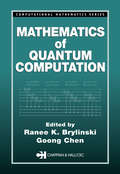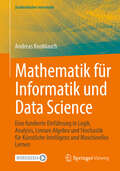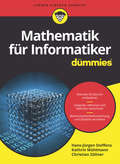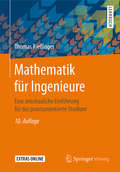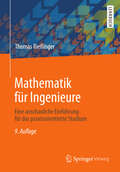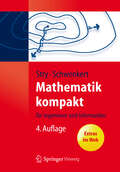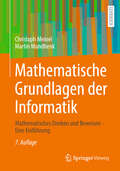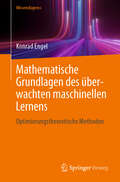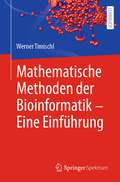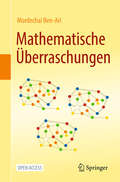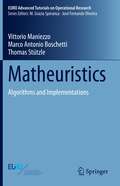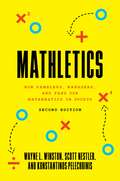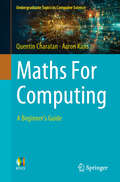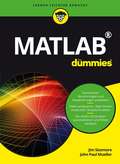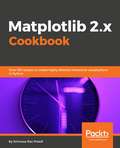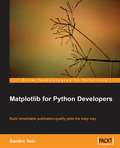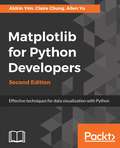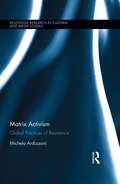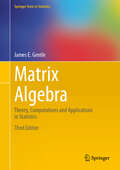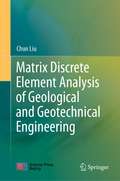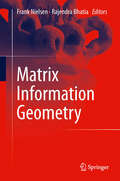- Table View
- List View
Mathematics of Quantum Computation
by Goong Chen Ranee K. BrylinskiAmong the most exciting developments in science today is the design and construction of the quantum computer. Its realization will be the result of multidisciplinary efforts, but ultimately, it is mathematics that lies at the heart of theoretical quantum computer science.Mathematics of Quantum Computation brings together leading computer sc
Mathematics of Quantum Computing: An Introduction
by Wolfgang SchererThis textbook presents the elementary aspects of quantum computing in a mathematical form. It is intended as core or supplementary reading for physicists, mathematicians, and computer scientists taking a first course on quantum computing. It starts by introducing the basic mathematics required for quantum mechanics, and then goes on to present, in detail, the notions of quantum mechanics, entanglement, quantum gates, and quantum algorithms, of which Shor's factorisation and Grover's search algorithm are discussed extensively. In addition, the algorithms for the Abelian Hidden Subgroup and Discrete Logarithm problems are presented and the latter is used to show how the Bitcoin digital signature may be compromised. It also addresses the problem of error correction as well as giving a detailed exposition of adiabatic quantum computing. The book contains around 140 exercises for the student, covering all of the topics treated, together with an appendix of solutions.
Mathematik für Informatik und Data Science: Eine fundierte Einführung in Logik, Analysis, Lineare Algebra und Stochastik für Künstliche Intelligenz und Maschinelles Lernen (Studienbücher Informatik)
by Andreas KnoblauchDieses Buch liefert eine kompakte aber fundierte Darstellung der wichtigsten Gebiete der Mathematik für Informatik, die insbesondere für Data Science, Künstliche Intelligenz und Maschinelles Lernen notwendig sind. Inhaltlich gehören dazu Grundlagen zu Logik und Beweisen, ein- und mehrdimensionale Analysis mit Differential- und Integralrechnung, Lineare Algebra mit Vektor- und Matrixrechnung, linearen Gleichungssystemen, Koordinatentransformationen, Eigenvektoren sowie Wahrscheinlichkeitsrechnung mit Grundlagen der Kombinatorik, Statistik und Informationstheorie. Trotz der kompakten Darstellung werden alle Konzepte und Sätze sorgfältig eingeführt und bewiesen. Nichts soll vom Himmel fallen, sondern aus Axiomen und elementaren Prinzipien hergeleitet werden. Ziel ist es beim Studierenden das befriedigende Gefühl zu erzeugen, alles von Grund auf verstanden zu haben, und nichts nur „glauben“ zu müssen.
Mathematik für Informatiker für Dummies (Für Dummies)
by Hans-Jürgen Steffens Christian Zöllner Kathrin MühlmannIst der Mathematik-Schein auch für Sie die größte Hürde im Studium? Dabei brauchen Sie als Informatiker solide mathematische Grundkenntnisse, um Algorithmen zu verstehen und mit Anwendern aus Naturwissenschaft und Technik auf Augenhöhe zu kommunizieren. Dieses Buch vermittelt Ihnen auf verständliche Weise und immer mit Querbezügen zur Informatik die mathematischen Grundlagen, die alle Informatiker benötigen: Aussagenlogik, Rekursion, Induktion, Relationen, Analysis, Wahrscheinlichkeitsrechnung, Statistik und lineare Algebra. Keine Sorge: Es werden lediglich Schulkenntnisse in Mathematik vorausgesetzt.
Mathematik für Informatiker: Ein praxisbezogenes Lehrbuch
by Peter HartmannDieses Buch enthält den Mathematikstoff, der für das Informatikstudium in anwendungsorientierten Bachelorstudiengängen benötigt wird. Der Inhalt entspringt der langjährigen Lehrerfahrung des Autors.Das heißt:Sie finden immer wieder Anwendungen aus der Informatik.Sie lernen nicht nur mathematische Methoden, es werden auch die Denkweisen der Mathematik vermittelt, die eine Grundlage zum Verständnis der Informatik bilden.Beweise werden dann geführt, wenn Sie daraus etwas lernen können, nicht um des Beweisens willen.Mathematik ist für viele Studierende zunächst ein notwendiges Übel. Das Buch zeigt durch ausführliche Motivation, durch viele Beispiele, durch das ständige Aufzeigen von Querbezügen zwischen Mathematik und Informatik, dass Mathematik nicht nur nützlich ist, sondern interessant sein kann und manchmal auch Spaß macht.
Mathematik für Ingenieure
by Thomas Rießinger"Mathematik in entspannter Atmosphäre" ist das Leitbild dieses leicht verständlichen Lehrbuchs. Im Erzählstil und mit vielen Beispielen beleuchtet der Autor nicht nur die Höhere Mathematik, sondern er stellt auch den Lehrstoff in Bezug zu den Anwendungen. Die gesamte für den Ingenieurstudenten wichtige Mathematik wird in einem Band behandelt. Dies gelingt durch Verzicht auf abstrakte Höhen und durch eine prüfungsgerechte Stoffauswahl, die sich streng an den Bedürfnissen des späteren Ingenieurs ausrichtet. Das Buch kann vorlesungsbegleitend oder zum Selbststudium eingesetzt werden. Die 159 Übungsaufgaben mit Lösungen unterstützen das Einüben des Lehrstoffs und sind im Band "Übungsaufgaben zur Mathematik für Ingenieure" ausführlich durchgerechnet.Der "Brückenkurs" beim Buch auf springer.com erleichtert Anfängern den Einstieg.
Mathematik für Ingenieure: Eine anschauliche Einführung für das praxisorientierte Studium
by Thomas Rießinger"Mathematik in entspannter Atmosphäre" ist das Leitbild dieses leicht verständlichen Lehrbuchs. Im Erzählstil und mit vielen Beispielen beleuchtet der Autor nicht nur die Höhere Mathematik, sondern er stellt auch den Lehrstoff in Bezug zu den Anwendungen. Die gesamte für den Ingenieurstudenten wichtige Mathematik wird in einem Band behandelt. Dies gelingt durch Verzicht auf abstrakte Höhen und durch eine prüfungsgerechte Stoffauswahl, die sich streng an den Bedürfnissen des späteren Ingenieurs ausrichtet. Das Buch kann vorlesungsbegleitend oder zum Selbststudium eingesetzt werden. Die 159 Übungsaufgaben mit Lösungen unterstützen das Einüben des Lehrstoffs und sind im Band "Übungsaufgaben zur Mathematik für Ingenieure" ausführlich durchgerechnet. Der "Brückenkurs" auf http://extras.springer.com/2013/978-3-642-36858-5 erleichtert Anfängern den Einstieg.
Mathematik kompakt
by Rainer Schwenkert Yvonne StryDas kompakte einbändige Werk bietet eine aktuelle Stoffauswahl mit Themen wie Wahrscheinlichkeitsrechnung und Statistik, dafür wird auf überflüssige Beweise verzichtet. Die Autoren präsentieren den gesamten Stoff in einem anschaulichen, aufgelockerten Stil - mit Zusammenfassungen und Verständnistests zu jedem Kapitel, Randnotizen für die schnelle Orientierung, Beispielen und Anwendungen sowie zahlreichen Übungsaufgaben mit Lösungen. Ergänzendes Material wie Folien und kommentierte Lösungen stehen im Internet zum Download bereit.
Mathematische Grundlagen der Informatik: Mathematisches Denken und Beweisen - Eine Einführung
by Christoph Meinel Martin MundhenkDie mathematischen Grundlagen der Informatik werden anhand von Definitionen und Beispielen anschaulich eingeführt. Ziel des Buches, nun in einer korrigierten und aktualisierten Fassung, ist es, systematisch die für die Informatik typischen und grundlegenden mathematischen Denkweisen vorzustellen – ohne dabei auf besondere, die übliche Schulmathematik übersteigende Vorkenntnisse aufzubauen.
Mathematische Grundlagen des überwachten maschinellen Lernens: Optimierungstheoretische Methoden
by Konrad EngelDieses Buch behandelt die gängigsten Methoden zur Klassifikation von digitalisierten Objekten. Jedem Objekt ist ein Punkt im Euklidischen Raum passender Dimension zugeordnet. Das Lernen basiert auf einer Menge von Punkten, für die die zugehörige Klasse bekannt ist. Eine Reduktion der Dimension sowie elementare und anspruchsvollere Methoden zur Ermittlung schnell berechenbarer Funktionen, mit denen man aus einem Punkt die zugehörige Klasse mit einer möglichst geringen Fehlerrate ableiten kann, werden hergeleitet und in einer einheitlichen Herangehensweise begründet. Die recht elementaren Beweise werden im Wesentlichen mit Mitteln der Linearen Algebra geführt, nur für die neuronalen Netze wird etwas Analysis benötigt.Die Produktfamilie WissensExpress bietet Ihnen Lehr- und Lernbücher in kompakter Form. Die Bücher liefern schnell und verständlich fundiertes Wissen.
Mathematische Methoden der Bioinformatik - Eine Einführung
by Werner TimischlGroße Datenmengen lassen sich ohne den Einsatz von einschlägigen Softwareprodukten kaum bearbeiten. Mit den bereitgestellten Algorithmen können Daten statistisch ausgewertet und Optimierungsaufgaben oder kombinatorische Problemstellungen gelöst werden. Auch wenn dies zumeist im „Black Box“-Verfahren geschieht, ist es doch hilfreich, etwa bei der Auswahl der Algorithmen oder bei der Einschätzung der erforderlichen Zeit-Ressourcen, die hinter den Algorithmen steckenden mathematischen Ideen zu kennen. Das Buch lädt Biologen und Mediziner ein, sich mit den mathematischen Grundlagen von ausgewählten Algorithmen der Bioinformatik vertraut zu machen. Es ist eine Einführung mit vielen durchgerechneten Beispielen und zahlreichen Aufgaben mit ausführlichen Lösungen zum Einüben der mathematischen Inhalte. Inhaltliche Schwerpunkte sind Matrizen, lineare Gleichungssysteme, Rekursionen, Abzähltechniken, diskrete dynamische Optimierung, Markov-Ketten, Hidden Markov-Modelle und distanzbasierte Klassifikationsverfahren.
Mathematische Überraschungen
by Mordechai Ben-AriDieses Buch ist Open-Access und bietet viele mathematische Überraschungen. Es gibt viele faszinierende Ergebnisse, die nicht in Lehrbüchern erscheinen, obwohl sie mit guten Kenntnissen der Sekundarschulmathematik zugänglich sind. Dieses Buch stellt eine Auswahl dieser Ergebnisse vor, darunter die mathematische Formalisierung von Origami, Konstruktionen mit Lineal und Zirkel (und anderen Instrumenten), die Fünf- und Sechs-Farben-Theoreme, eine Kostprobe der Ramsey-Theorie und wenig bekannte Theoreme, die durch mathematische Induktion bewiesen werden. Zu den überraschendsten Theoremen gehören das Mohr-Mascheroni-Theorem, das besagt, dass alle klassischen Konstruktionen die mit Lineal und Zirkel ausgeführt werden können, tatsächlich sogar nur mit einem Zirkel ausgeführt werden können, und das Steinersche Theorem, das besagt, dass ein Lineal allein ausreicht, wenn ein einziger Kreis gegeben ist. Der Höhepunkt des Buches ist eine detaillierte Darstellung des rein algebraischen Beweises von Gauß, dass ein regelmäßiges Heptadekagon (ein regelmäßiges Polygon mit siebzehn Seiten) mit Lineal und Zirkel konstruiert werden kann. Obwohl die in diesem Buch verwendete Mathematik elementar ist (euklidische und analytische Geometrie, Algebra, Trigonometrie), werden Schüler und Studenten an weiterführenden Schulen und Hochschulen, Lehrer und andere interessierte Leser gerne die Gelegenheit nutzen, sich der Herausforderung zu stellen, diese überraschenden Theoreme zu verstehen.
Matheuristics: Algorithms and Implementations (EURO Advanced Tutorials on Operational Research)
by Thomas Stützle Vittorio Maniezzo Marco Antonio BoschettiThis book is the first comprehensive tutorial on matheuristics. Matheuristics are based on mathematical extensions of previously known heuristics, mainly metaheuristics, and on original, area-specific approaches. This tutorial provides a detailed discussion of both contributions, presenting the pseudocodes of over 40 algorithms, abundant literature references, and for each case a step-by-step description of a sample run on a common Generalized Assignment Problem example. C++ source codes of all algorithms are available in an associated SW repository.
Mathletics: How Gamblers, Managers, and Fans Use Mathematics in Sports, Second Edition
by Wayne L. Winston Konstantinos Pelechrinis Scott NestlerHow to use math to improve performance and predict outcomes in professional sportsMathletics reveals the mathematical methods top coaches and managers use to evaluate players and improve team performance, and gives math enthusiasts the practical skills they need to enhance their understanding and enjoyment of their favorite sports—and maybe even gain the outside edge to winning bets. This second edition features new data, new players and teams, and new chapters on soccer, e-sports, golf, volleyball, gambling Calcuttas, analysis of camera data, Bayesian inference, ridge regression, and other statistical techniques. After reading Mathletics, you will understand why baseball teams should almost never bunt; why football overtime systems are unfair; why points, rebounds, and assists aren’t enough to determine who’s the NBA’s best player; and more.
Maths For Computing: A Beginner's Guide (Undergraduate Topics in Computer Science)
by Quentin Charatan Aaron KansThis introductory textbook covers all the mathematical concepts necessary for a computing degree, limiting coverage only to the material needed for the fundamentals of computing rather than delving into the higher mathematical concepts. Key features include: Gears content toward students who are less confident in mathematics Provides exercises, with solutions, at the end of each chapter Teaches topics using everyday language Includes numerous worked examples in every chapter Uses familiar scenarios to introduce mathematical concepts Discusses the relevance of each chapter topic to the world of computing Core topics covered include: Set and groups Matrices Relations and functions Logic and proofs Combinatorics Probability Graph theory The book is written for students embarking on an undergraduate or foundation degree course in computer science (or related discipline) and aims to provide the basic skills and knowledge of discrete mathematics required for such a course. Whereas many textbooks tend to teach this subject in a way that is more suitable for mathematicians, this text specifically targets first-year students on computing courses and aims to teach only the basic material that they will need for their computing degree. Dr Quentin Charatan is a former Principal Lecturer and now visiting lecturer at the University of East London, UK. Dr Aaron Kans is the Head of the Computer Science and Digital Technologies Department in the School of Architecture, Computing & Engineering at the same institution.
Matlab für Dummies (Für Dummies)
by Jim SizemoreOb Naturwissenschaftler, Mathematiker, Ingenieur oder Datenwissenschaftler - mit MATLAB haben Sie ein mächtiges Tool in der Hand, das Ihnen die Arbeit mit Ihren Daten erleichtert. Aber wie das mit manch mächtigen Dingen so ist - es ist auch ganz schön kompliziert. Aber keine Sorge! Jim Sizemore führt Sie in diesem Buch Schritt für Schritt an das Programm heran - von der Installation und den ersten Skripten bis hin zu aufwändigen Berechnungen, der Erstellung von Grafiken und effizienter Fehlerbehebung. Sie werden begeistert sein, was Sie mit MATLAB alles anstellen können.
Matlab für Dummies (Für Dummies)
by John Paul Mueller Jim SizemoreMATLAB® So lernen Sie MATLAB ideal zu nutzen Ob Naturwissenschaftler, Mathematiker, Ingenieur oder Datenwissenschaftler - mit MATLAB haben Sie ein mächtiges Tool in der Hand, das Ihnen die Arbeit mit Ihren Daten erleichtert. Aber wie das mit manch mächtigen Dingen so ist - es ist auch ganz schön kompliziert. Aber keine Sorge! Die Autoren führen Sie in diesem Buch Schritt für Schritt an das Programm heran - von der Installation und den ersten Skripten bis hin zu aufwändigen Berechnungen, der Erstellung von Grafiken und effizienter Fehlerbehebung. Sie werden begeistert sein, was Sie mit MATLAB alles anstellen können. Sie erfahren Was es mit dem MATLAB-Dateisystem auf sich hat Wie Sie mathematische Operationen mit Vektoren und Matrizen durchführen Wie Sie Funktionen und Skripte erstellen Wie Sie importieren, exportieren und publizieren.
Matplotlib 3.0 Cookbook: Over 150 recipes to create highly detailed interactive visualizations using Python
by Srinivasa Rao PoladiBuild attractive, insightful, and powerful visualizations to gain quality insights from your dataKey FeaturesMaster Matplotlib for data visualizationCustomize basic plots to make and deploy figures in cloud environmentsExplore recipes to design various data visualizations from simple bar charts to advanced 3D plotsBook DescriptionMatplotlib provides a large library of customizable plots, along with a comprehensive set of backends. Matplotlib 3.0 Cookbook is your hands-on guide to exploring the world of Matplotlib, and covers the most effective plotting packages for Python 3.7. With the help of this cookbook, you'll be able to tackle any problem you might come across while designing attractive, insightful data visualizations. With the help of over 150 recipes, you'll learn how to develop plots related to business intelligence, data science, and engineering disciplines with highly detailed visualizations. Once you've familiarized yourself with the fundamentals, you'll move on to developing professional dashboards with a wide variety of graphs and sophisticated grid layouts in 2D and 3D. You'll annotate and add rich text to the plots, enabling the creation of a business storyline. In addition to this, you'll learn how to save figures and animations in various formats for downstream deployment, followed by extending the functionality offered by various internal and third-party toolkits, such as axisartist, axes_grid, Cartopy, and Seaborn. By the end of this book, you'll be able to create high-quality customized plots and deploy them on the web and on supported GUI applications such as Tkinter, Qt 5, and wxPython by implementing real-world use cases and examples.What you will learnDevelop simple to advanced data visualizations in Matplotlib Use the pyplot API to quickly develop and deploy different plots Use object-oriented APIs for maximum flexibility with the customization of figuresDevelop interactive plots with animation and widgets Use maps for geographical plotting Enrich your visualizations using embedded texts and mathematical expressionsEmbed Matplotlib plots into other GUIs used for developing applicationsUse toolkits such as axisartist, axes_grid1, and cartopy to extend the base functionality of MatplotlibWho this book is forThe Matplotlib 3.0 Cookbook is for you if you are a data analyst, data scientist, or Python developer looking for quick recipes for a multitude of visualizations. This book is also for those who want to build variations of interactive visualizations.
Matplotlib for Python Developers
by Sandro TosiThis is a practical, hands-on book, with a lot of code and images. It presents the real code that generates every image and describes almost every single line of it, so that you know exactly what's going on. Introductory, descriptive, and theoretical parts are mixed with examples, so that reading and understanding them is easy. All of the examples build gradually with code snippets, their explanations, and plot images where necessary with the complete code and output presented at the end. This book is essentially for Python developers who have a good knowledge of Python; no knowledge of Matplotlib is required. You will be creating 2D plots using Matplotlib in no time at all.
Matplotlib for Python Developers: Effective techniques for data visualization with Python, 2nd Edition
by Allen Yu Claire Chung Aldrin YimLeverage the power of Matplotlib to visualize and understand your data more effectivelyKey FeaturesPerform effective data visualization with Matplotlib and get actionable insights from your dataDesign attractive graphs, charts, and 2D plots, and deploy them to the webGet the most out of Matplotlib in this practical guide with updated code and examplesBook DescriptionPython is a general-purpose programming language increasingly being used for data analysis and visualization. Matplotlib is a popular data visualization package in Python used to design effective plots and graphs. This is a practical, hands-on resource to help you visualize data with Python using the Matplotlib library. Matplotlib for Python Developers, Second Edition shows you how to create attractive graphs, charts, and plots using Matplotlib. You will also get a quick introduction to third-party packages, Seaborn, Pandas, Basemap, and Geopandas, and learn how to use them with Matplotlib. After that, you’ll embed and customize your plots in third-party tools such as GTK+3, Qt 5, and wxWidgets. You’ll also be able to tweak the look and feel of your visualization with the help of practical examples provided in this book. Further on, you’ll explore Matplotlib 2.1.x on the web, from a cloud-based platform using third-party packages such as Django. Finally, you will integrate interactive, real-time visualization techniques into your current workflow with the help of practical real-world examples.By the end of this book, you’ll be thoroughly comfortable with using the popular Python data visualization library Matplotlib 2.1.x and leveraging its power to build attractive, insightful, and powerful visualizations.What you will learnCreate 2D and 3D static plots such as bar charts, heat maps, and scatter plotsGet acquainted with GTK+3, Qt5, and wxWidgets to understand the UI backend of MatplotlibDevelop advanced static plots with third-party packages such as Pandas, GeoPandas, and SeabornCreate interactive plots with real-time updatesDevelop web-based, Matplotlib-powered graph visualizations with third-party packages such as DjangoWrite data visualization code that is readily expandable on the cloud platformWho this book is forThis book is essentially for anyone who wants to create intuitive data visualizations using the Matplotlib library. If you’re a data scientist or analyst and wish to create attractive visualizations using Python, you’ll find this book useful. Some knowledge of Python programming is all you need to get started.
Matrices, Statistics and Big Data: Selected Contributions from IWMS 2016 (Contributions to Statistics)
by S. Ejaz Ahmed Simo Puntanen Francisco CarvalhoThis volume features selected, refereed papers on various aspects of statistics, matrix theory and its applications to statistics, as well as related numerical linear algebra topics and numerical solution methods, which are relevant for problems arising in statistics and in big data. The contributions were originally presented at the 25th International Workshop on Matrices and Statistics (IWMS 2016), held in Funchal (Madeira), Portugal on June 6-9, 2016. The IWMS workshop series brings together statisticians, computer scientists, data scientists and mathematicians, helping them better understand each other’s tools, and fostering new collaborations at the interface of matrix theory and statistics.
Matrix Activism: Global Practices of Resistance (Routledge Research in Cultural and Media Studies)
by Michela ArdizzoniThe intersection of virtual and physical spaces at the heart of contemporary political protests is a pivotal element in new practices of activism. In this new and global ecology of dissent and activism, different forces, stakeholders, and spaces, once defiantly discordant, come together to define the increasingly malleable nature and terms of participatory politics and the performance of democracy. This book explores the emerging sites, aesthetics and politics of contemporary dissent as a critical attempt to foreground their mediation and negotiation in an era of neoliberal globalization. Contemporary forms of media activism occupy deeply ambivalent spaces, which Ardizzoni analyzes using the lens of what she calls "matrix activism." Rather than confining the analysis to a single platform, a single technology, or a single social actor, matrix activism allows us to explain the hybrid nature of new forms of dissent and resistance, as they are located at the intersection of alternative and mainstream, non-profit and corporate, individual and social, production and consumption, online and offline.
Matrix Algebra: Theory, Computations and Applications in Statistics (Springer Texts in Statistics)
by James E. GentleThis book presents the theory of matrix algebra for statistical applications, explores various types of matrices encountered in statistics, and covers numerical linear algebra. Matrix algebra is one of the most important areas of mathematics in data science and in statistical theory, and previous editions had essential updates and comprehensive coverage on critical topics in mathematics.This 3rd edition offers a self-contained description of relevant aspects of matrix algebra for applications in statistics. It begins with fundamental concepts of vectors and vector spaces; covers basic algebraic properties of matrices and analytic properties of vectors and matrices in multivariate calculus; and concludes with a discussion on operations on matrices, in solutions of linear systems and in eigenanalysis. It also includes discussions of the R software package, with numerous examples and exercises.Matrix Algebra considers various types of matrices encountered in statistics, such as projection matrices and positive definite matrices, and describes special properties of those matrices; as well as describing various applications of matrix theory in statistics, including linear models, multivariate analysis, and stochastic processes. It begins with a discussion of the basics of numerical computations and goes on to describe accurate and efficient algorithms for factoring matrices, how to solve linear systems of equations, and the extraction of eigenvalues and eigenvectors. It covers numerical linear algebra—one of the most important subjects in the field of statistical computing. The content includes greater emphases on R, and extensive coverage of statistical linear models. Matrix Algebra is ideal for graduate and advanced undergraduate students, or as a supplementary text for courses in linear models or multivariate statistics. It’s also ideal for use in a course in statistical computing, or as a supplementary text forvarious courses that emphasize computations.
Matrix Discrete Element Analysis of Geological and Geotechnical Engineering
by Chun LiuThis book introduces the basic structure, modeling methods, numerical calculation processes, post-processing, and system functions of MatDEM, which applies the basic principles and algorithm of the discrete element method. The discrete element method can effectively simulate the discontinuity, inhomogeneity, and large deformation damage of rock and soil. It is widely used in both research and industry. Based on the innovative matrix discrete element computing method, the author developed the high-performance discrete element software MatDEM from scratch, which can handle millions of elements in discrete element numerical simulations. This book also presents several examples of applications in geological and geotechnical engineering, including basic geotechnical engineering problems, discrete element tests, three dimensional landslides, and dynamic and multi-field coupling functions. Teaching videos and the relevant software can be accessed on the MATDEM website (http://matdem.com). The book serves as a useful reference for research and engineering staff, undergraduates, and postgraduates who work in the fields of geology, geotechnical, water conservancy, civil engineering, mining, and physics.
Matrix Information Geometry
by Rajendra Bhatia Frank NielsenThis book presents advances in matrix and tensor data processing in the domain of signal, image and information processing. The theoretical mathematical approaches are discusses in the context of potential applications in sensor and cognitive systems engineering. The topics and application include Information Geometry, Differential Geometry of structured Matrix, Positive Definite Matrix, Covariance Matrix, Sensors (Electromagnetic Fields, Acoustic sensors) and Applications in Cognitive systems, in particular Data Mining.
